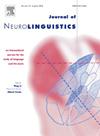Within- and cross-modal translation priming: An event-related potential investigation with Chinese-English bilinguals
IF 1.2
3区 心理学
Q2 LINGUISTICS
引用次数: 0
Abstract
The present study used event-related potentials (ERPs) to investigate and compare the temporal dynamics of cross-linguistic lexical-semantic activation during English written and spoken word recognition in unbalanced Chinese (L1)-English (L2) bilinguals. Participants were tested in a L1-L2 translation recognition task, where L1 words were visually presented and L2 words were visually or auditorily presented. The ERP results revealed that, relative to the non-translation equivalents, the translation equivalents elicited a more negative N200 amplitude (100–300 ms, i.e., N200 enhancement effect) regardless of modalities. Furthermore, the ERP translation priming effects (i.e., less negative or more positive ERP waveforms) were observed in the 300-600-ms time period for within-modal presentation and 400-1000-ms time period for cross-modal presentation. The early N200 enhancement effects reflected a cross-linguistic whole-word orthographic activation during L2 written and spoken word processing and demonstrated a bidirectional interactive link between the L1 and L2 lexical representations, which was not modulated by the change of processing modality. The late ERP priming effects reflected the cross-linguistic lexical-semantic activation and integration processes at later stages. Additionally, the lexical-semantic link of within-modal L1-L2 word pairs was more robust than that of cross-modal pairs, as reflected by larger ERP priming effects in the typical N400 time period (300–500 ms). In contrast, bilinguals might need additional cognitive resources to integrate the lexical-semantic information of cross-modal word pairs, as reflected by larger ERP priming effects in the LPC time period (600–900 ms).
内模态和跨模态翻译启动:中英双语者事件相关电位的研究
本研究利用事件相关电位(ERPs)研究并比较了非平衡汉语-英语双语者在英语书面和口语单词识别过程中跨语言词汇-语义激活的时间动态。参与者在L1-L2翻译识别任务中进行测试,其中L1单词被视觉呈现,L2单词被视觉或听觉呈现。ERP结果显示,无论何种方式,相对于非翻译等效物,翻译等效物引发了更负的N200振幅(100-300 ms,即N200增强效应)。此外,在模态内呈现的300-600 ms和跨模态呈现的400-1000 ms时间内,观察到ERP的翻译启动效应(即负ERP波形较少或正ERP波形较多)。早期的N200增强效应反映了在二语书面和口语词汇加工过程中跨语言的全词正字法激活,并表明母语和二语词汇表征之间存在双向交互联系,这种联系不受加工方式变化的调节。后期ERP启动效应反映了后期跨语言词汇语义激活和整合过程。此外,模态内词对的词汇语义联系比跨模态词对更强,这在典型的N400时间段(300-500 ms)表现为更大的ERP启动效应。相比之下,双语者可能需要额外的认知资源来整合跨模态词对的词汇语义信息,这反映在LPC时段(600-900 ms)更大的ERP启动效应上。
本文章由计算机程序翻译,如有差异,请以英文原文为准。
求助全文
约1分钟内获得全文
求助全文
来源期刊

Journal of Neurolinguistics
医学-神经科学
CiteScore
3.90
自引率
5.00%
发文量
49
审稿时长
17.2 weeks
期刊介绍:
The Journal of Neurolinguistics is an international forum for the integration of the neurosciences and language sciences. JNL provides for rapid publication of novel, peer-reviewed research into the interaction between language, communication and brain processes. The focus is on rigorous studies of an empirical or theoretical nature and which make an original contribution to our knowledge about the involvement of the nervous system in communication and its breakdowns. Contributions from neurology, communication disorders, linguistics, neuropsychology and cognitive science in general are welcome. Published articles will typically address issues relating some aspect of language or speech function to its neurological substrates with clear theoretical import. Interdisciplinary work on any aspect of the biological foundations of language and its disorders resulting from brain damage is encouraged. Studies of normal subjects, with clear reference to brain functions, are appropriate. Group-studies on well defined samples and case studies with well documented lesion or nervous system dysfunction are acceptable. The journal is open to empirical reports and review articles. Special issues on aspects of the relation between language and the structure and function of the nervous system are also welcome.
 求助内容:
求助内容: 应助结果提醒方式:
应助结果提醒方式:


